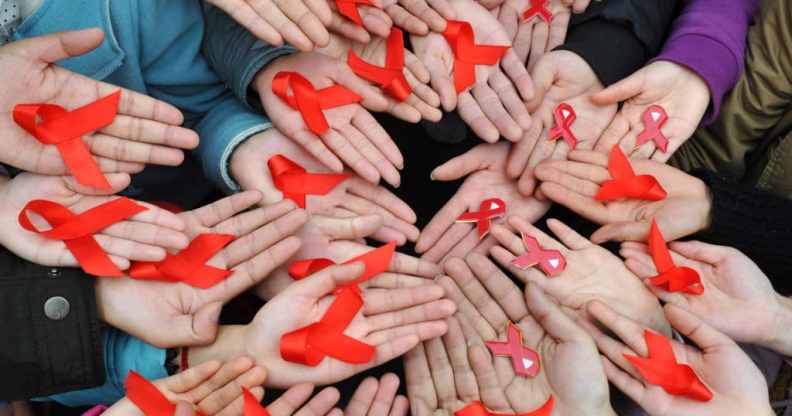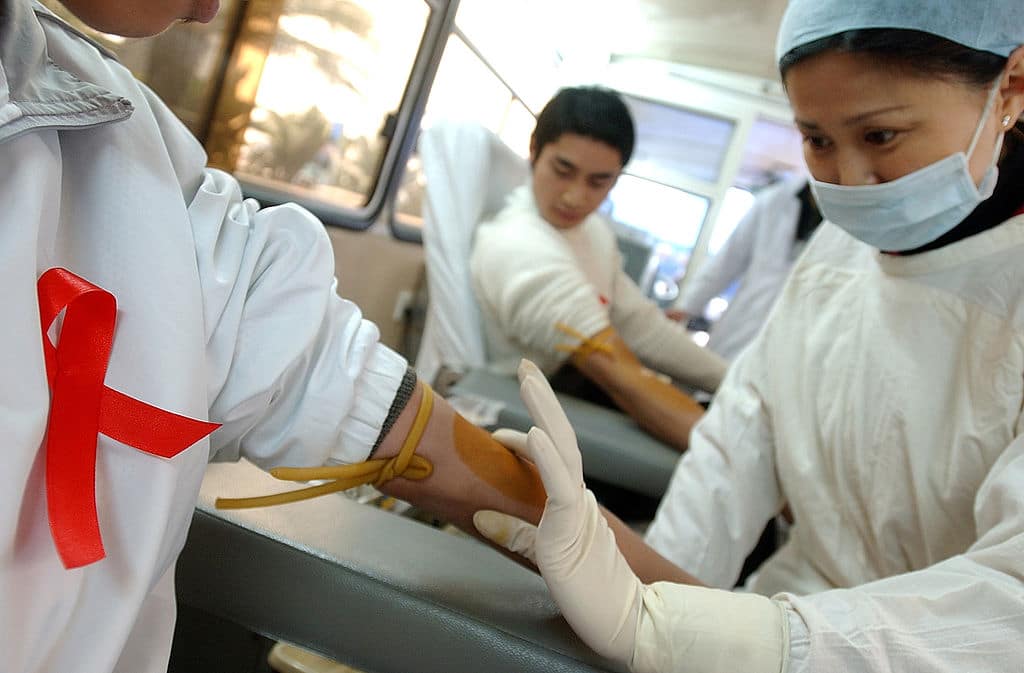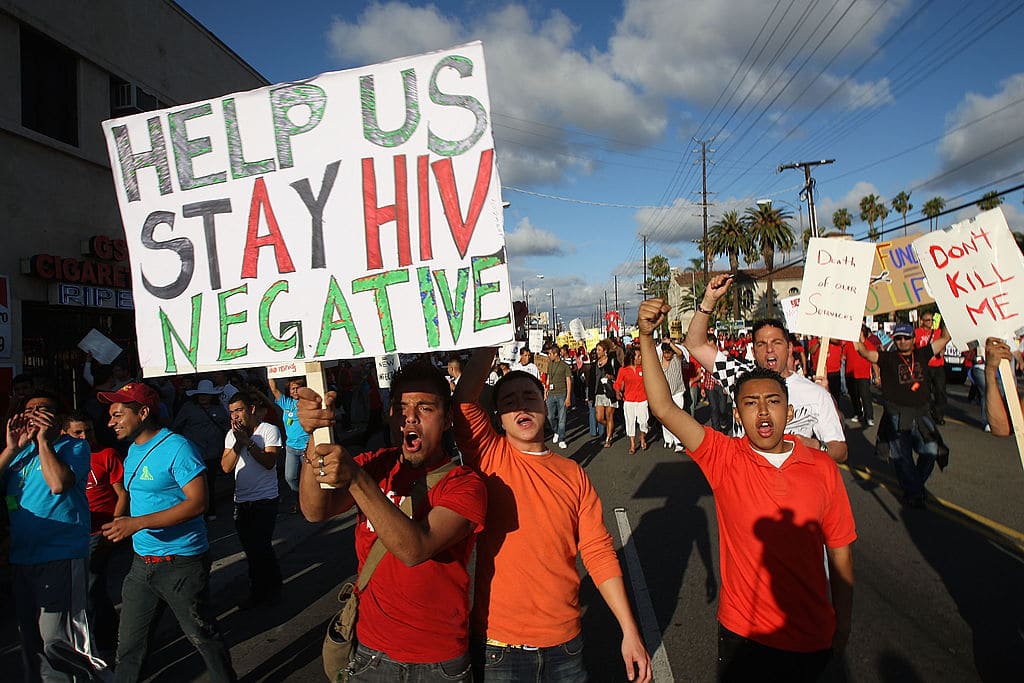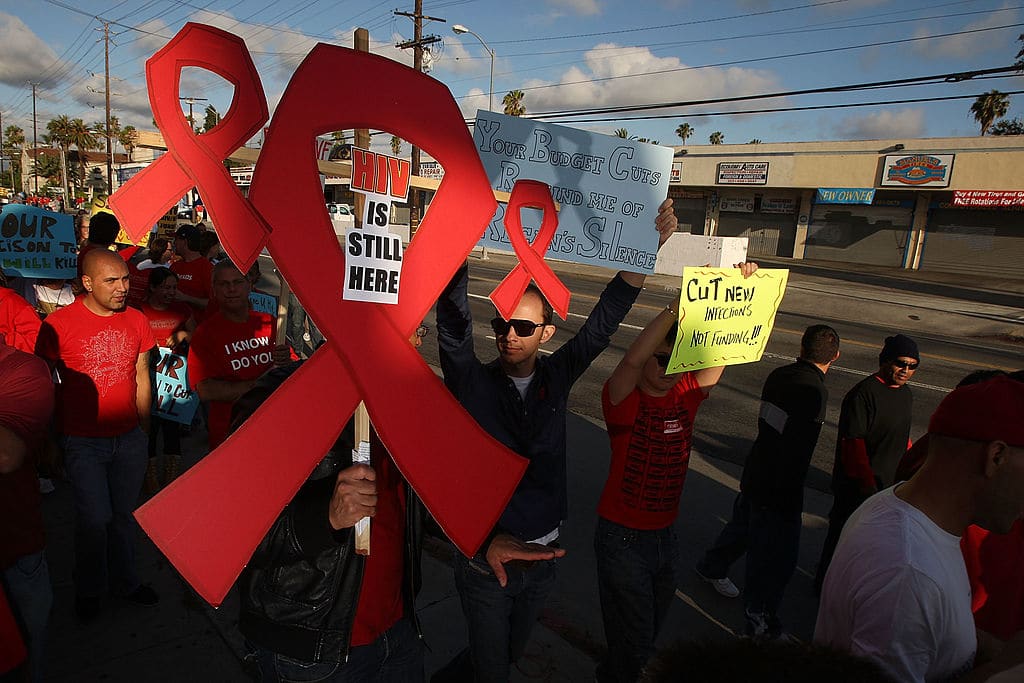Hundreds of thousands of people with HIV are still dying every year – and it’s entirely preventable

University students display red ribbons during an event to promote the awareness of AIDS at the Sichuan University on World AIDS Day 2009. (China Photos/Getty)
Thanks to breakthroughs in medical science, HIV has been a manageable condition for more than 20 years.
Despite this, people are still dying from AIDS across the world in alarming numbers. According to UNAIDS, an estimated 680,000 people died from AIDS related illnesses in 2020 alone. It is thought that around 1.5 million people acquired the virus last year.
These deaths are entirely preventable – if everyone was diagnosed early and was able to access treatment, they could live long, happy lives.
Anne Aslett is chief executive at the Elton John AIDS Foundation. She says global inequalities mean that the AIDS epidemic is continuing across the world – even in an era where illness and death can be stopped.
“We were making enormous progress on the global AIDS epidemic – of course, COVID has thrown a massive bomb into the middle of that,” she tells PinkNews.
Antiretroviral medication came on stream in the 1990s, and it revolutionised the outlook for people diagnosed with HIV. Today, people on effective treatment can reduce the viral load in their bloodstream to an undetectable level, meaning they won’t develop AIDS and, crucially, they can’t pass the virus on – even through condomless sex.
The result is that HIV is not the death sentence it once was. Huge swathes of people who have HIV now have a full lifespan to look forward to – they can live well into old age, and it’s all thanks to antiretroviral treatment.
But Aslett notes that there has been “large growth in infections” in middle income countries in Eastern Europe and Central Asia over the last decade. Issues also persist for minoritised groups in North America – there have been “extraordinary advances”, and those with health insurance can access treatment and testing – but persistent inequalities mean some cohorts have worse outcomes.
Did you know that #HIV can be prevented by taking pre-exposure prophylaxis or PrEP as well as by using condoms? If you think you might be at risk of HIV infection, contact your healthcare provider today.
More about PrEP for HIV prevention: https://t.co/j8tKetaXCx#WorldAIDSDay pic.twitter.com/6OCUJQSXk5
— World Health Organization (WHO) Western Pacific (@WHOWPRO) November 30, 2021
“If you’re a Black gay man in America you have a one in two lifetime chance of contracting HIV,” Aslett says. “And of course there are more health system challenges in certain parts of the world like sub-saharan Africa and parts of Asia and the Pacific, but really it’s more about who you are rather than where you are.
“So-called vulnerable populations – the LGBTQ community, people who use drugs, people who sell sex, people in prison and their partners – make up 62 per cent of infections worldwide. So I think what we’ve really got to concentrate on is where are the vulnerable groups around the world and how do we best support them?”
HIV stigma and criminalisation of homosexuality are feeding the AIDS epidemic
To move forward, Aslett says discrimination and stigma must be challenged at every turn.
“If you’re gay, there are still over 70 countries and territories worldwide that criminalise consensual same-gender sex. If what you do and who you love is illegal, your agency or likelihood to engage with the healthcare system, to be open about who you are and to openly seek testing and access to treatment, is going to be massively reduced,” Aslett explains. “We’ve seen this in eastern Europe and Central Asia – it’s one of the reasons why it’s got this galloping epidemic.”
She says similar issues exist for drug users, sex workers, and young people. She points out that AIDS is one of the biggest killers of younger people in sub-saharan Africa, which Aslett says is partly due to “lack of access to information” as well as a lack of agency.

A nurse prepares to collect blood from a donor during a volunteer blood donation campaign to mark World AIDS Day on December 1, 2005 in China. (China Photos/Getty)
“I think the big things we can do is look at the structural barriers for vulnerable populations that stop them being open and accessing the information, treatment, care and support they need,” Aslett says. “Some of that is around decriminalisation and some of it is around social inclusion policies, because it isn’t just health. If you’re discriminated against in your community, where you work, in education, all of that is going to limit your ability to access the care and support you need.”
We talk about three plus million people dying of COVID, which is appalling and terrible, but more than 36 million people have died of AIDS.
Aslett thinks there is a lack of education and awareness more broadly about the true impact of AIDS worldwide that has been further exacerbated by the COVID-19 pandemic. For many people, HIV and AIDS have fallen off the radar – but the AIDS epidemic is far from over.
“We talk about three plus million people dying of COVID, which is appalling and terrible, but more than 36 million people have died of AIDS,” she says. “It’s a horrific epidemic and it remains a terrible epidemic.”
Aslett says the world also has a tendency to “move on” from certain issues. “They have their moment and then it seems like the news agenda moves on, politicians move on. One of the things that’s been enormously successful in reminding people about HIV and AIDS, if you look at the UK, was It’s a Sin. People stop reading the statistics in the press, but if you give them a human story, it really lands with people. After It’s a Sin aired, the HIV testing rates went up by thousands of per cent because suddenly it’s present for people again.”

AIDS Healthcare Foundation (AHF) and AIDS patients march to protest millions of dollars in cuts to life-saving AIDS services proposed by California Governor Arnold Schwarzenegger in 2009. (David McNew/Getty)
Aslett has been heartened by the global response to COVID-19, and it has given her hope that the same tools could be used to end new HIV transmissions and further reduce the global death toll of AIDS.
“Let’s not entirely shift our focus from one pandemic to another, let’s incorporate what we already do for AIDS and other pandemics – tuberculosis, malaria – let’s find ways to learn from those and incorporate the COVID response into that,” Aslett says. “It’s the same set of people who are most vulnerable to all of these diseases – it’s about poverty, it’s about social exclusion and lack of agency, so you get the same groups being affected over and over again. In North America, you see African American communities and Latinx communities being much more affected by COVID in the same way that they have been much more affected by HIV.”
Increased access to HIV testing can save lives – and it can also end the epidemic
Like Aslett, Deborah Gold, who is chief executive of the National AIDS Trust, thinks there are a range of issues that need to be tackled if the global death rate from AIDS is to be reduced. She says each one of those deaths is “unforgivable” because they are entirely preventable.
“I think the reasons why those deaths still happen is down to a range of different things,” she says. “It’s to do with access to healthcare – medication is one part of it, and although there have been amazing strides in terms of access to medication, you also need the right health infrastructure to deliver the medication.”
Gold agrees that stigma plays an enormous role in making sure the AIDS epidemic continues.
“We have to deal with the enormous level of stigma that still exists in the UK and around the world with HIV,” Gold explains. “That stigma can prevent people from testing for HIV in the first place. It can prevent people from feeling able to maintain their medication regime, and it can affect the quality of life of people living with HIV.”
Increasing access to HIV testing is essential, Gold says. It has the power to save lives – and it can also bring us closer to ending the epidemic.

AIDS Healthcare Foundation (AHF) and AIDS patients march to protest millions of dollars in cuts to life-saving AIDS services proposed by California Governor Arnold Schwarzenegger in 2009. (David McNew/Getty)
“In the first place, the later that you’re diagnosed with HIV after you acquire it, the worse your health outcomes will be,” she says. “It is absolutely crucial to diagnose people as quickly as possible after they acquire HIV so they have the best chance of living a long and healthy life.
“Once you’re on medication and you have an undetectable viral load, you’re unable to pass HIV on to anyone else. That’s the most important thing in moving towards the end of the epidemic, and it’s important in ensuring the highest possible quality of life for people living with HIV by ensuring that they’re diagnosed early and that they’re able to access treatment and support.”
The AIDS epidemic is now 40 years old. Aslett notes that we have made “extraordinary progress” – but she says there is still a long way to go.
“It’s a constant struggle, and it’s hard over 40 years to keep the focus and the agenda on HIV,” she says. “This pandemic has existed for a long time. We don’t have a cure, and that means that there are millions of people all around the world living with HIV who need support to maintain their treatment and live a good life.”

